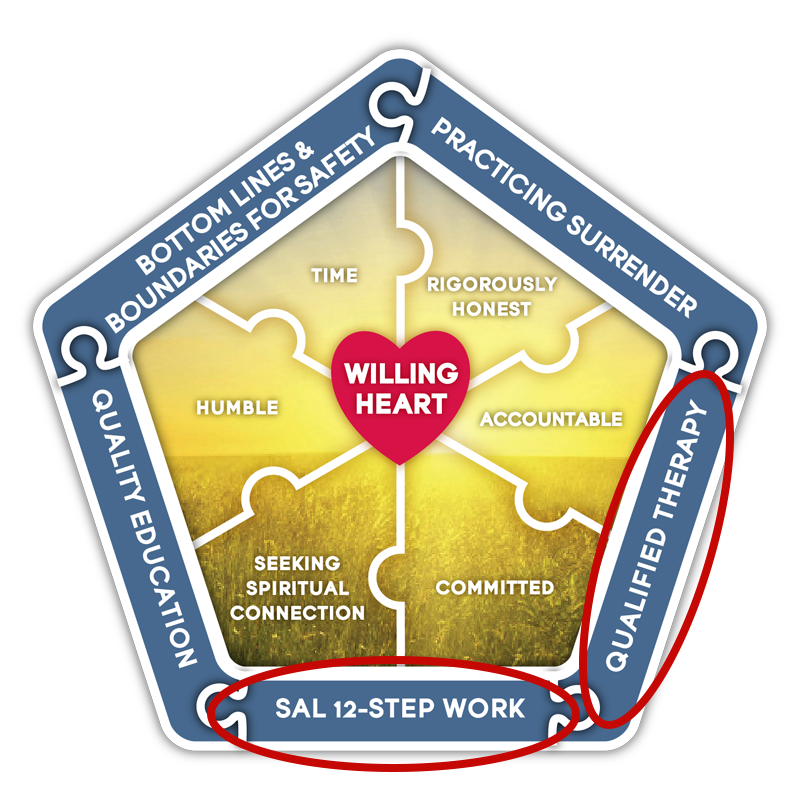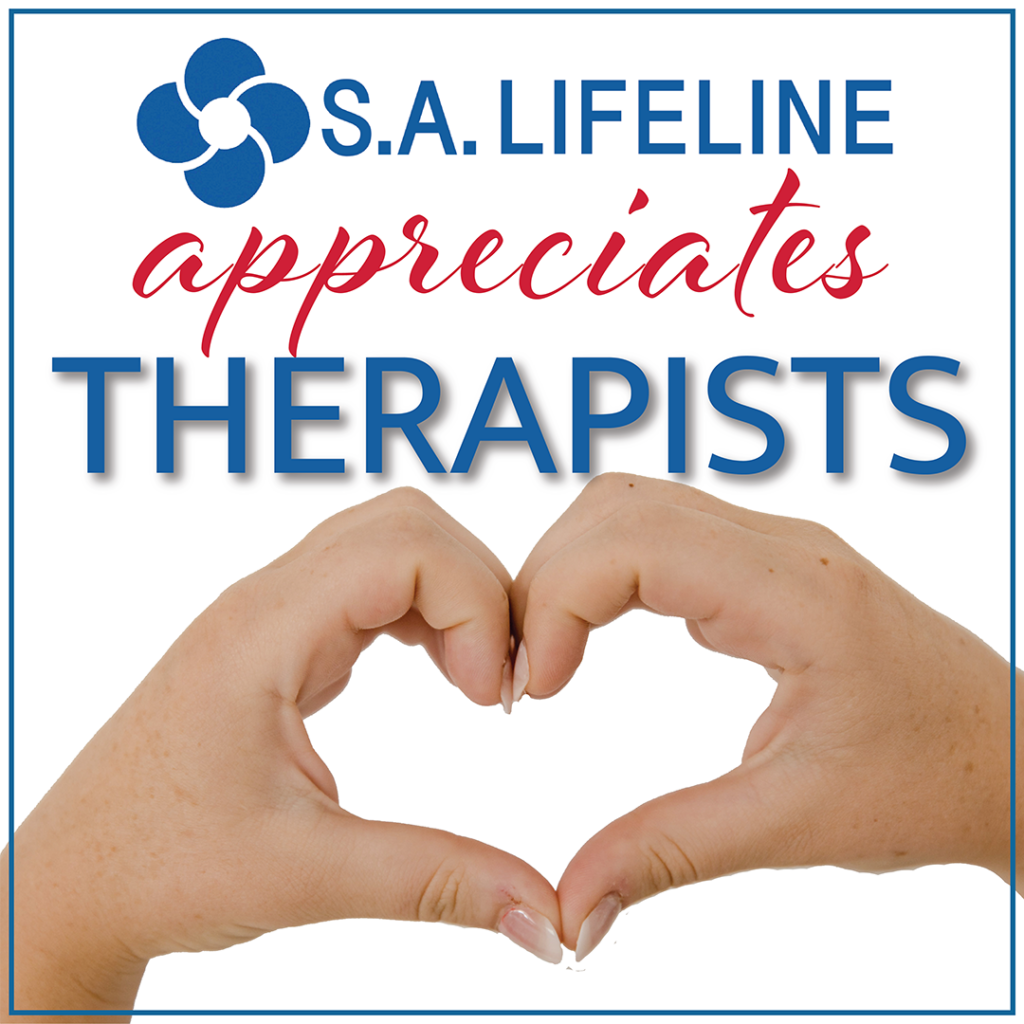Featuring Video From Dr. Jill Manning

In the journey of navigating recovery from sexual compulsions/ addictions and betrayal trauma, two powerful forces often stand as pillars of support: therapy and the Twelve-Steps. While distinct in their approaches, they possess a remarkable symbiotic relationship that fosters profound healing and personal growth. Let’s explore how therapy and 12-steps complement and reinforce each other on the path to recovery.
The Recovery Puzzle:
At S.A. Lifeline, we like to look at the healing journey like a puzzle where every piece is important. We’ve recently added more puzzle pieces to our Recovery Puzzle to make recovery more complete. Please notice that SAL 12-Step work and Qualified Therapy are parts of the border:

We have taken notice that there are generally positive differences between those who attend both Therapy and 12-Steps, vs those who only attend one or the other.
Why 12-Steps?
To guide the healing journey exists the 12-Steps, a set of guiding principles originally formulated by Alcoholics Anonymous (AA) and now adopted by various recovery programs including SAL 12-Step. Rooted in spirituality and self-reflection, the 12-Steps offer a structured framework for individuals to address addictive behaviors and/ or betrayal trauma, make amends for past wrongs, and cultivate a deeper connection with themselves and the God of their understanding.
“Both addiction and trauma trap us in a state of isolation where we feel alone, ashamed, afraid, and disconnected from others. Though it may seem impossible from this mindset, we can choose to leave all this misery behind. But it means we must be willing to step outside of ourselves and find people who can support the changes we want to make in our lives.
Choosing to participate in the SAL 12-Step program is an important first choice on this path. It offers priceless gifts of connection and community. Any and all who suffer from the effects of sexual addiction are welcome here. In this fellowship, we feel accepted and uniquely understood by those who have walked this road before us. We discover the freedom of authenticity as we shake off the burden, shame and hidden secrets.” (From the SAL Recovering Individuals, Healing Families book.)
Twelve-Steps also offers a community of people in various stages of recovery, which can help with hope, accountability and isolation.
Why Therapists Often Recommend 12-Steps
Therapists often recommend 12-steps to their clients for various reasons, including community, financial concerns (12-Steps is FREE, though donations are appreciated), self-awareness and accountability.
For instance, Dan Drake, LMFT, LPCC, CCPS-S, CSAT-S, says in this Pathway To Recovery podcast episode, “for the addict… I try to get them… linked to a 12 step community pretty early if I can, because that’s where they’re going to do a lot of their healing.”
We also greatly appreciate Dr. Jill Manning, PHD, LMFT, CCPS, recommending SAL 12-Steps to her clients. Dr. Manning lists 5 reasons why she recommends SAL 12-Steps in this short video:
Understanding Qualified Therapy:
Therapy serves as a cornerstone in the realm of mental health and addiction recovery. It provides a safe and nurturing space where individuals can delve into their innermost thoughts, emotions, and experiences. “A qualified, licensed therapist is best suited to treat the specific issues that pertain to recovering addicts and betrayed partners. Without qualified therapy, there is a risk of inflicting additional trauma and offering advice that can be damaging. While other sources may offer comfort and support — clergy, life coaches, or well-meaning friends and family members — they typically lack the critical educational background and experience that effective therapy requires.” (See this FREE download for questions to help you know if your therapist is a good personal fit.)

The Symbiotic Relationship:
At first glance, therapy and the 12-Steps may be distinct entities with divergent approaches, however their primary goals align and the different approaches are highly complementary to each other. Upon closer examination, their symbiotic relationship becomes evident. Therapy provides the introspective groundwork, allowing individuals to unearth buried traumas, identify destructive patterns, and cultivate self-awareness. In parallel, the 12-Steps offer a spiritual roadmap, guiding individuals towards acceptance, forgiveness, and personal transformation.
One of our participants tells her story of how she came to have an awareness of this:
“When I first began recovery from betrayal trauma, I started in therapy and group therapy. As I was coming into group therapy, another woman was getting ready to exit the program because she had completed the requirements. I began walking with this new found friend who had decided to start attending SAL 12-Step after her graduation from the program. Even though my friend had experienced significant change and healing in therapy, which she had attended for several years, when she started to attend SAL 12-Step I noticed that she was learning, growing and healing in new and profound ways. I wanted to experience more thorough healing like my friend, and as such I began attending SAL 12-Step as well. For me, the 2 just go together like peanut butter and jelly.”
Moreover, therapy and the 12-Steps offer mutual support, bolstering each other’s efficacy in profound ways. When done well, both modalities encourage growth in areas of self awareness, education and accountability, giving the struggling individual the best tools and support system for genuine, thorough and life-long healing.
Conclusion:
In the intricate tapestry of addiction recovery and betrayal trauma treatment, therapy and the Twelve Steps emerge as symbiotic forces, each enriching and reinforcing the other. Through the integration of introspection, spiritual principles, and communal support, individuals embark on a transformative journey of healing, growth, and self-discovery. Embracing this symbiosis opens the door to profound insights, lasting change, and a life filled with meaning and purpose.






